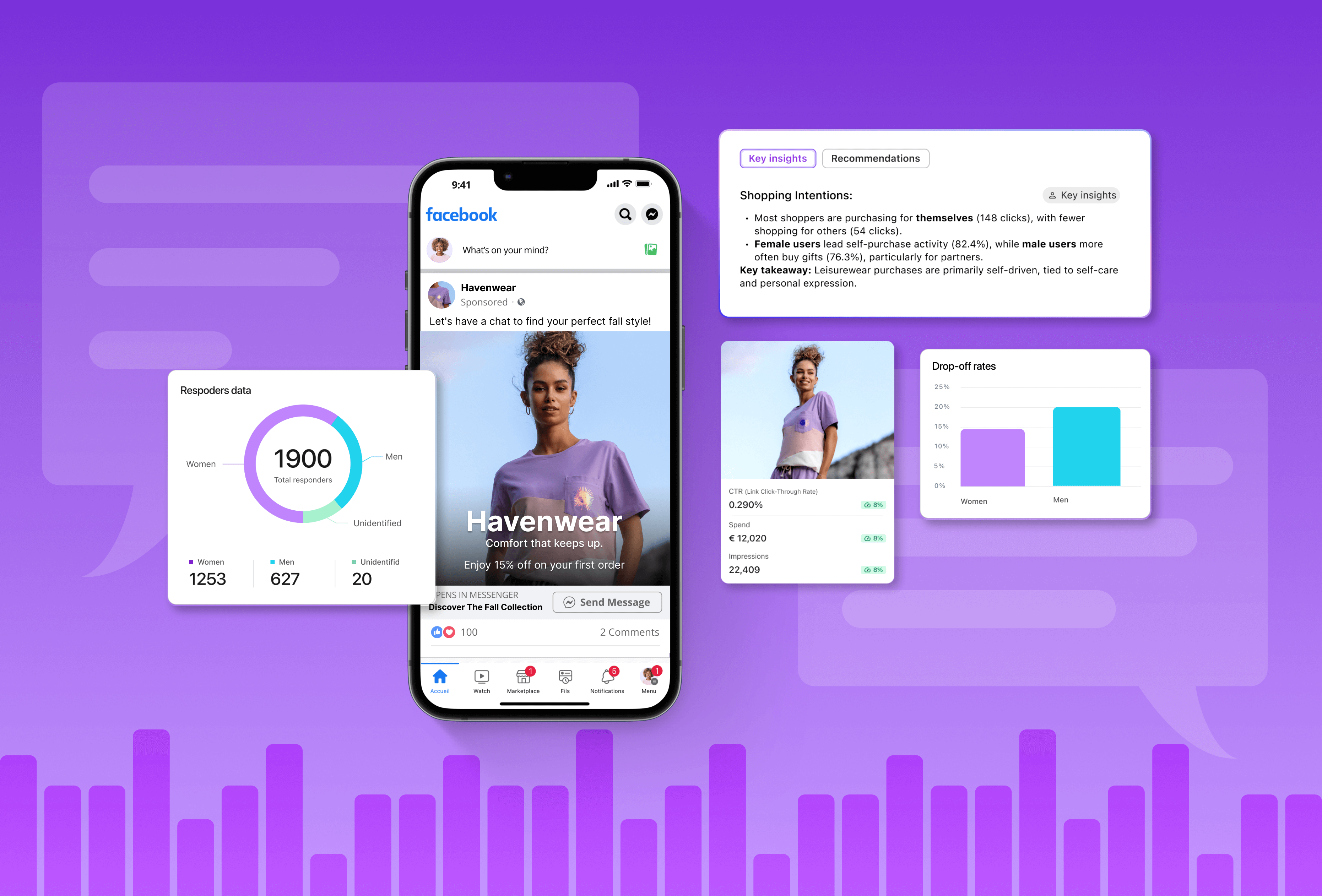
AI and Advertising in 2025: What Consumers Really Expect
AI has moved from hype to habit. Nearly 90% of consumers now use AI weekly, with daily usage climbing year over year. As adoption accelerates, expectations are shifting: people want ads that feel more personal, trustworthy, and culturally relevant.
In our recent AI in Advertising: What Consumers Expect report, we explored this dynamic in depth. Here, we’re highlighting a few additional findings from our research that didn’t make the final report, offering a preview of the themes shaping consumer sentiment around AI and advertising today.
1. Freshness Over Frequency
Consumers are signaling that repetitive ads are a fast track to irrelevance. In fact, 84% say ads that rotate or update instead of repeating the same version feel more relevant, while nearly two in five admit they feel uncomfortable when the same ad follows them after they’ve ignored it.
The message is clear: audiences value variety and storytelling. AI offers a path forward by helping brands deliver creative that adapts, rather than simply increasing frequency. The future isn’t about showing up more often. It’s about showing up differently.
2. The Persistent Relevance Gap
Despite advances in personalization, many consumers still feel unseen. Sixty percent say ads try to speak to everyone at once, while only 45% feel the ads they see are truly relevant to them.
This disconnect is especially strong among younger audiences, who expect brands to meet them with empathy and cultural resonance. The implication for marketers: data alone doesn’t close the gap. Creative narratives, emotional context, and timing remain critical to building meaningful connections.
3. Trust Requires a Human Touch
Consumers may welcome AI in advertising, but they don’t want machines working alone. Our research shows that 48% trust ads co-created by a person with AI support, compared to just 13% who trust ads created entirely by AI.
This underscores the importance of transparency and human oversight. People want to know when AI is involved, and they expect brands to balance efficiency with authenticity. The winning formula isn’t man or machine – it’s man and machine.
4. AI as a Force for Good
Beyond efficiency, consumers see AI’s potential to improve accessibility and level the playing field. Seventy-two percent believe AI can make advertising more inclusive through translations and transcriptions, while 67% say it lowers creative barriers for small businesses, helping them compete with larger players.
This perspective reframes AI as more than a performance tool. When applied thoughtfully, it can help brands foster inclusivity, expand representation, and deliver messages to audiences who may have been underserved in the past.
Discover More Consumer AI Insights
These insights only scratch the surface of how AI is reshaping the advertising landscape. To explore the full findings, including how consumers define personalization, which creative signals matter most, and where brands are succeeding or falling short, download AI in Advertising: What Consumers Expect.
FAQ: AI and Advertising in 2025
Curious how these findings translate to real-world expectations? Here are the most common questions we get about AI and advertising in 2025.
Do consumers trust AI-generated ads?
Only a small fraction fully trust ads created entirely by AI. Most prefer ads co-created by humans and AI, and nearly half say disclosure is essential to building trust.
What personalization do consumers want from AI ads?
They value inputs like hobbies, life stage, and mood, but reject overly intrusive data like private messages, health history, or constant location tracking.
How can AI make advertising more inclusive?
Consumers highlight AI’s potential to support small businesses, improve accessibility through translation, and audit ads for bias and stereotypes.
What matters more: ad frequency or freshness?
Freshness wins. Consumers prefer ads that adapt and evolve instead of repeating the same creative endlessly.

AI has moved from hype to habit. Nearly 90% of consumers now use AI weekly, with daily usage climbing year over year. As adoption accelerates, expectations are shifting: people want ads that feel more personal, trustworthy, and culturally relevant.
In our recent AI in Advertising: What Consumers Expect report, we explored this dynamic in depth. Here, we’re highlighting a few additional findings from our research that didn’t make the final report, offering a preview of the themes shaping consumer sentiment around AI and advertising today.
1. Freshness Over Frequency
Consumers are signaling that repetitive ads are a fast track to irrelevance. In fact, 84% say ads that rotate or update instead of repeating the same version feel more relevant, while nearly two in five admit they feel uncomfortable when the same ad follows them after they’ve ignored it.
The message is clear: audiences value variety and storytelling. AI offers a path forward by helping brands deliver creative that adapts, rather than simply increasing frequency. The future isn’t about showing up more often. It’s about showing up differently.
2. The Persistent Relevance Gap
Despite advances in personalization, many consumers still feel unseen. Sixty percent say ads try to speak to everyone at once, while only 45% feel the ads they see are truly relevant to them.
This disconnect is especially strong among younger audiences, who expect brands to meet them with empathy and cultural resonance. The implication for marketers: data alone doesn’t close the gap. Creative narratives, emotional context, and timing remain critical to building meaningful connections.
3. Trust Requires a Human Touch
Consumers may welcome AI in advertising, but they don’t want machines working alone. Our research shows that 48% trust ads co-created by a person with AI support, compared to just 13% who trust ads created entirely by AI.
This underscores the importance of transparency and human oversight. People want to know when AI is involved, and they expect brands to balance efficiency with authenticity. The winning formula isn’t man or machine – it’s man and machine.
4. AI as a Force for Good
Beyond efficiency, consumers see AI’s potential to improve accessibility and level the playing field. Seventy-two percent believe AI can make advertising more inclusive through translations and transcriptions, while 67% say it lowers creative barriers for small businesses, helping them compete with larger players.
This perspective reframes AI as more than a performance tool. When applied thoughtfully, it can help brands foster inclusivity, expand representation, and deliver messages to audiences who may have been underserved in the past.
Discover More Consumer AI Insights
These insights only scratch the surface of how AI is reshaping the advertising landscape. To explore the full findings, including how consumers define personalization, which creative signals matter most, and where brands are succeeding or falling short, download AI in Advertising: What Consumers Expect.
FAQ: AI and Advertising in 2025
Curious how these findings translate to real-world expectations? Here are the most common questions we get about AI and advertising in 2025.
Do consumers trust AI-generated ads?
Only a small fraction fully trust ads created entirely by AI. Most prefer ads co-created by humans and AI, and nearly half say disclosure is essential to building trust.
What personalization do consumers want from AI ads?
They value inputs like hobbies, life stage, and mood, but reject overly intrusive data like private messages, health history, or constant location tracking.
How can AI make advertising more inclusive?
Consumers highlight AI’s potential to support small businesses, improve accessibility through translation, and audit ads for bias and stereotypes.
What matters more: ad frequency or freshness?
Freshness wins. Consumers prefer ads that adapt and evolve instead of repeating the same creative endlessly.
Honestly, we'd rather just show you.
Chat with our team to see how Smartly transforms the fragmented advertising ecosystem into something suspiciously manageable.





.webp)


%201%20(1)%201%201.avif)

